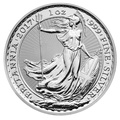Silver Thursday
‘Silver Thursday’ is the most infamous day in modern history for silver investors. The day in question refers specifically to Thursday 27th March, 1980.
The Hunt brothers – Nelson Bunker Hunt, William Herbert Hunt, and Lamar Hunt - had purchased enough physical and paper silver to effectively corner the market. The COMEX adopted 'Silver Rule 7’ to counteract their monopoly attempt and the silver market, as well as other commodity markets, crashed in the chaos. Silver Thursday was the day the crash began. In their eyes the Hunt brothers had failed to meet financial obligations, putting them at risk of losing billions...
What is Silver Thursday?
When Texas oil billionaire Haroldson Lafayette Hunt Jr. died in 1974, his sons used their new fortunes to invest in a number of markets, including oil, soybeans, horses and silver.
Following years of war spending and unresponsive fiscal policies, the US Dollar was plagued by high inflation over the course of the 1960s and 70s. The hard conservative Hunt family were outspoken in their belief that the economic future was volatile, and after President Nixon abandoned the gold standard in 1971 many worldwide economies were no longer supported by a physical asset. Instead they switched to paper-based fiat currencies.
At the time, owning gold in America was illegal, and it had been since the 1930s. Instead, the Hunt brothers turned to silver as a physical safe haven asset to protect their fortunes. Between 1973 and 1979 the three brothers – through personal investment, family members, and the funding of a number of banks and brokers – amassed a stockpile of roughly 42 million ounces of physical silver.
To make matters worse, they also owned an even greater number of silver futures contracts. In total it is estimated they had bought out 69% of the entire COMEX silver futures, and owned about $4.5 billion worth of silver in total, despite spending only a billion of their own money.
The Hunt brothers have always denied trying to corner the silver market and manipulate prices, instead claiming they wanted only to hedge against the volatility of the US economy. In some ways, the decision to take delivery of all the silver when their futures contracts expired supports this, but it was instead deemed a deliberate attempt to manipulate the market.
Whether a deliberate attempt to drive prices up, or the result of cautious men with a lot of money, the results speak for themselves.
To view today's silver price, click here.
As more and more physical silver was purchased and stockpiled by the Hunt brothers in Switzerland, supply became scarcer, and the price of silver soared.
Between 1979 and 1980, the price for an ounce of silver went from $6.54 to $38.30 - an increase of 485%. The markets responded accordingly, with people rushing to find any spare silver lying around their houses, and industries relying on silver seeing costs significantly increase. Tiffany & Co. infamously took out a full page advert in the New York Times to very publicly condemn the brothers.
The Tiffany & Co. advert in the New York Times on March 26th 1980 - the day before Silver Thursday - read as follows:
Unconscionable
We think it is unconscionable for anyone to hoard several billion, yes billion, dollars worth of silver and thus drive the price up so high that others must pay artificially high prices for articles made of silver, from baby spoons to tea sets, as well as photographic film and other products.
With prices rising, and supply being depleted by the brothers’ actions, the rules for purchasing commodities on margin were changed. On January 7th 1980, the COMEX adopted ‘Silver Rule 7’ which restricted the margin requirements on silver futures, and the results were soon felt. Seeing that the Hunt’s buying practices were being curtailed, the credit being offered to them vanished. The price of silver began to fall, and when it reached the minimum margin requirements on the Hunt’s futures contracts they were required to pay huge sums in margin calls.
Having already leveraged billions to finance their purchases, the Hunt brothers found themselves desperately trying to raise more funds, or sell off silver to meet the new demands. The Hunt name was still good enough to keep the brothers afloat for two months, but meeting the margin calls cost them millions.
On March 27th – Silver Thursday itself – the Hunt brothers finally missed a margin call of $100 million to the Bache brokerage firm, and the market plunged, with silver leading the way. By April 1st, the price of silver had dropped from $21.25 to $10.80, wiping off half of its value in a few days.

The impact of Silver Thursday was felt across all markets globally. Gold saw significant rises and falls in March 1980, and the threat of the Hunt brother’s losing a potential $1.7 billion caused panic in the stock markets.
Unable to raise the money needed to pay off their margin calls, the Hunt brothers were at risk of losing enough money to bankrupt a number of brokers and banks across the US, threatening to destabilise America’s already weak economy. In order to keep the economy steady, a conglomerate of US banks and brokers provided a credit line of $1.1 billion to the Hunt brothers to meet their obligations. The market was stabilised, but for the Hunts it meant complete failure; their days of being some of America’s richest men were effectively over, though they did remain millionaires - hardly a terrible end to what had been a disastrous market response.
The men were eventually bankrupted, after being convicted of trying to illegally corner the silver market. Failing to disclose their financial stake in Bache also added insider trading to their list of felonies. Fined $10 million each, and owing millions to the Internal Revenue Service, the brothers were also banned from any future trading on the commodities market.
Are the Hunt brothers still alive?
Nelson Bunker Hunt died in 2014, at the age of 88. Having lost most of his money in the aftermath of Silver Thursday, he turned to thoroughbred horse racing in 1999, spending $2 million on horses and stables.
William Herbert Hunt is still alive; born in 1929 he is now 94 years old. Following bankruptcy in 1990, William Herbert Hunt continued in other business ventures and was estimated to be worth $2 billion in 2015.
Lamar Hunt died in 2006 due to prostate cancer. He is famed in America for his contribution to the founding of the American Football League (AFL), which would go on to merge with the NFL, as founding Major League Soccer (MLS) and its forerunner. Lamar also had investments in basketball, tennis and ice hockey.
Silver Thursday is a lesson for all investors as to the effects a few individuals can have on a market. The Hunt brothers are not the only people to attempt to manipulate market prices in this way, and the basic principle of supply and demand holds true for any asset. Regulations and rules are often stretched or tested by those hoping to make money at the expense of others.
- How To Buy Gold
- How to Buy?
- Payment Options
- Delivery Options
- Gold Storage
- Storage at Brink's
- Gold Investment Guide
- Why buy gold?
- Is gold a good investment?
- Why physical gold?
- Best time to buy gold?
- Gold bars vs coins?
- Gold vs Silver
- Gold - Silver Ratio explained
- VAT on bullion
- CGT on bullion
- Legal tender coins
- Top 5 Gold Investments
- Top 5 Silver Investments
- Gold vs ISAs
- Gold vs Buy-to-Let
- Gold vs FTSE 100
- Gold vs Bitcoin
- Where to buy gold?
- Why buy from us?
- Where to sell gold?
- Coin Shops
- Gold Price Forecasts
- Top 10 Gold Producers
- Top 10 Gold Reserves
- Gold Britannia vs Sovereign
- Britannia coin designs
- Sovereign coin designs
- Sovereign Mintages
- Sovereign mint marks
- British coin specs
- What is a proof coin?
- Royal Mint bullion
- The Queen's Beasts
- Royal Mint Lunar Coins
- Bullion Refiners
- British coin mints
- Krugerrands
- Gold Tola - India & Pakistan
- Bullion Index











